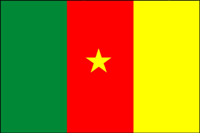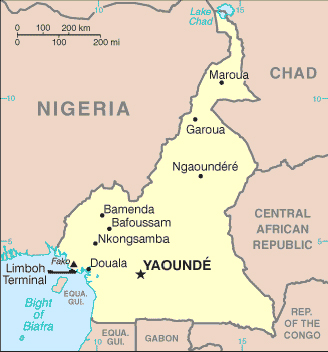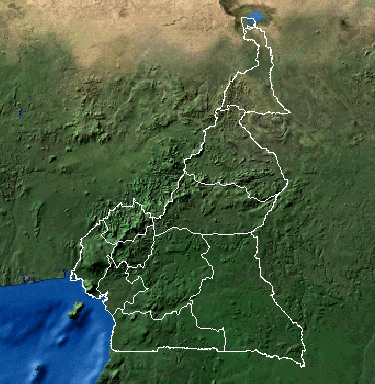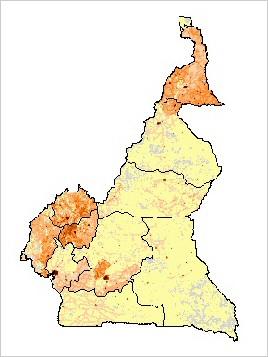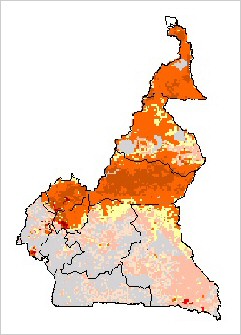|
|
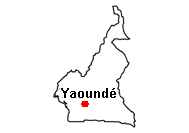 |
| |
back to top | ||
|
Population. Population very small. In 1975, small populations of cheetah were still found in Benoue National Park. Between 1974 and 1976, a census was carried out in Bouba Nr’dijida National Park, which resulted in finding no cheetah. Principal Threats. Decline of prey species, poaching and environmental degradation |
|||
|
|
|||
|
|||
|
Background: The former French Cameroon and part of British Cameroon merged in 1961 to form the present country. Cameroon has generally enjoyed stability, which has permitted the development of agriculture, roads, and railways, as well as a petroleum industry. Despite a slow movement toward democratic reform, political power remains firmly in the hands of an ethnic oligarchy headed by President Paul BIYA. |
|||
| |
back to top |
|
Area: total: 475,440 sq km; land: 469,440 sq km; water: 6,000 sq km Climate: varies with terrain, from tropical along coast to semiarid and hot in north Terrain: diverse, with coastal plain in southwest, dissected plateau in center, mountains in west, plains in north Natural resources: petroleum, bauxite, iron ore, timber, hydropower Land use: arable land: 12.54%; permanent crops: 2.52%; other: 84.94% (2005) Irrigatedland: 260 sq km (2003) Naturalhazards: volcanic activity with periodic releases of poisonous gases from Lake Nyos and Lake Monoun volcanoes Environment - current issues: waterborne diseases are prevalent; deforestation; overgrazing; desertification; poaching; overfishing international agreements: party to: Biodiversity, Climate Change, Climate Change-Kyoto Protocol, Desertification, Endangered Species, Hazardous Wastes, Law of the Sea, Ozone Layer Protection, Tropical Timber 83, Tropical Timber 94; signed, but not ratified: none of the selected agreements |
|
|
|
|
| |
back to top |
|
Population: 17,340,702; note: estimates for this country explicitly take into account the effects of excess mortality due to AIDS; this can result in lower life expectancy, higher infant mortality and death rates, lower population and growth rates, and changes in the distribution of population by age and sex than would otherwise be expected (July 2006 est.) Age structure: 0-14 years: 41.2% (male 3,614,430/female 3,531,047); 15-64 years: 55.5% (male 4,835,453/female 4,796,276); 65 years and over: 3.2% (male 260,342/female 303,154) (2006 est.) Median age: total: 18.9 years; male: 18.7 years; female: 19 years (2006 est.) Population growth rate: 2.04% (2006 est.) Infant mortality rate: total: 63.52 deaths/1,000 live births; male: 67.38 deaths/1,000 live births; female: 59.53 deaths/1,000 live births (2006 est.) Life expectancy at birth: total population: 51.16 years; male: 50.98 years; female: 51.34 years (2006 est.) Total fertility rate: 4.39 children born/woman (2006 est.) HIV/AIDS - adult prevalence rate: 6.9% (2003 est.) HIV/AIDS - people living with HIV/AIDS: 560,000 (2003 est.) HIV/AIDS - deaths: 49,000 (2003 est.) |
|
|
Ethnic groups: Cameroon Highlanders 31%, Equatorial Bantu 19%, Kirdi 11%, Fulani 10%, Northwestern Bantu 8%, Eastern Nigritic 7%, other African 13%, non-African less than 1% Religions: indigenous beliefs 40%, Christian 40%, Muslim 20% Languages: 24 major African language groups, English (official), French (official) Literacy: definition: age 15 and over can read and write; total population: 79%; male: 84.7%; female: 73.4% (2003 est.) |
|
| |
back to top |
|
Data Code: CM Government type: republic; multiparty presidential regime Independence: 1 January 1960 (from French-administered UN trusteeship) Legal system: based on French civil law system, with common law influence; accepts compulsory ICJ jurisdiction Political pressure groups and leaders: Southern Cameroon National Council [Ayamba Ette OTUN]; Human Rights Defense Group [Albert MUKONG, president] |
|
| |
back to top |
|
Economy - overview: Because of its modest oil resources and favorable agricultural conditions, Cameroon has one of the best-endowed primary commodity economies in sub-Saharan Africa. Still, it faces many of the serious problems facing other underdeveloped countries, such as a top-heavy civil service and a generally unfavorable climate for business enterprise. Since 1990, the government has embarked on various IMF and World Bank programs designed to spur business investment, increase efficiency in agriculture, improve trade, and recapitalize the nation's banks. In June 2000, the government completed an IMF-sponsored, three-year structural adjustment program; however, the IMF is pressing for more reforms, including increased budget transparency, privatization, and poverty reduction programs. International oil and cocoa prices have a significant impact on the economy. GDP - real growth rate: 4.1% (2006 est.) GDP - composition by sector: agriculture: 45.2%; industry: 16.1%; services: 38.7% (2006 est.) Labor force: 6.394 million (2006 est.) Labor force - by occupation: agriculture: 70%; industry: 13%; services: 17% Unemployment rate: 30% (2001 est.) Population below poverty line: 48% (2000 est.) |
|
|
Agriculture - products: coffee, cocoa, cotton, rubber, bananas, oilseed, grains, root starches; livestock; timber Industries: petroleum production and refining, aluminum production, food processing, light consumer goods, textiles, lumber, ship repairIndustrial production growth rate: 4.2% (1999 est.) Exports: $4.318 billion f.o.b. (2006 est.) Exports - commodities: crude oil and petroleum products, lumber, cocoa beans, aluminum, coffee, cotton Exports - partners: Spain 17.4%, Italy 13.8%, France 9.5%, South Korea 8.1%, UK 8.1%, Netherlands 7.9%, Belgium 4.9%, US 4.3% (2005) Imports: $3.083 billion f.o.b. (2006 est.) Imports - commodities: machinery, electrical equipment, transport equipment, fuel, food Imports - partners: France 24%, Nigeria 12%, Belgium 6.3%, China 5.6%, US 5.1%, Thailand 4.5%, Germany 4.2% (2005) Currency (code): Communaute Financiere Africaine franc (XAF); note - responsible authority is the Bank of the Central African States Exchange rates: Communaute Financiere Africaine francs (XAF) per US dollar - 522.592 (2006), 527.47 (2005), 528.29 (2004), 581.2 (2003), 696.99 (2002) |
|
| |
back to top |
|
Telephone system: general assessment: available only to business and government; domestic: cable, microwave radio relay, and tropospheric scatter; international: country code - 237; satellite earth stations - 2 Intelsat (Atlantic Ocean); fiber optic submarine cable (SAT-3/WASC) provides connectivity to Europe and Asia Radio broadcast stations: AM 2, FM 9, shortwave 3 (2002) Television broadcast stations: 1 (2002) Internet country code: .cm Internet hosts: 39 (2006) Internet users: 167,000 (2005) |
|
| |
back to top |
|
Marker L., Malouf J. and Malouf A. 1999. Appendix 2: The status of the wild cheetah in its range countries. In: 1999 International Cheetah Studbook. |
